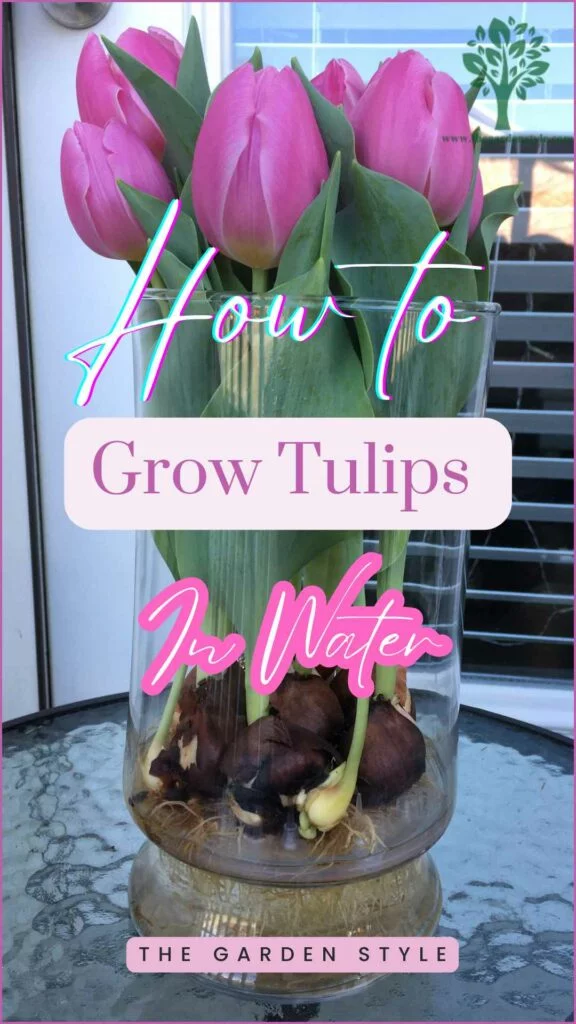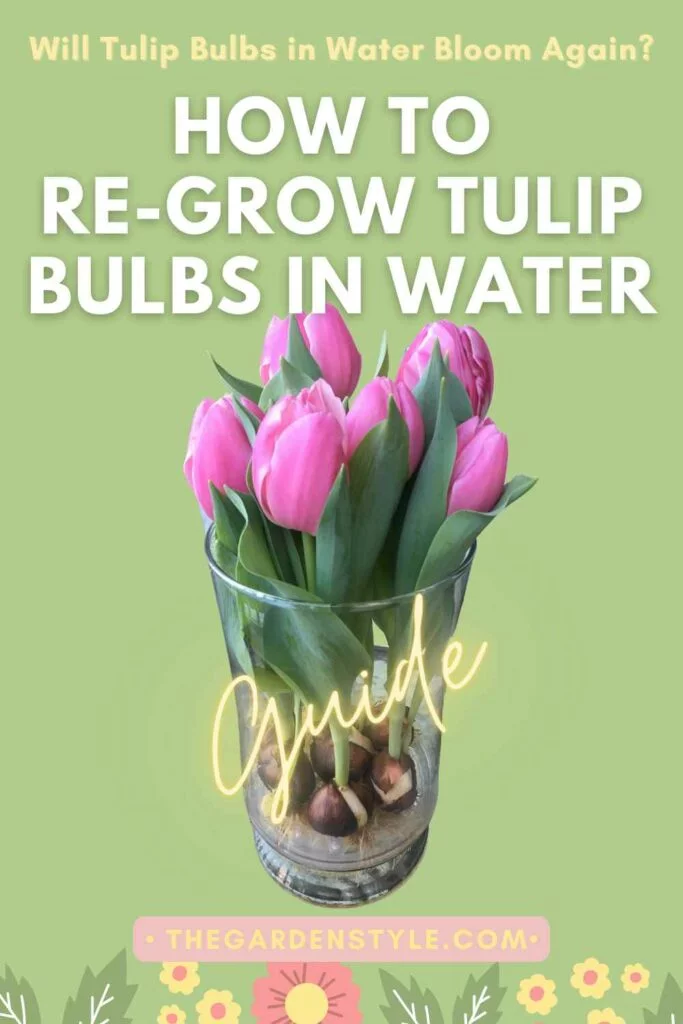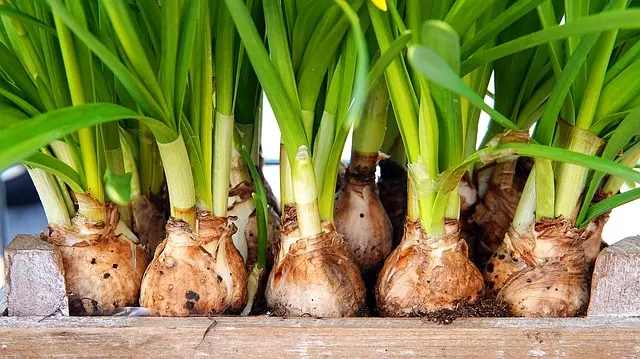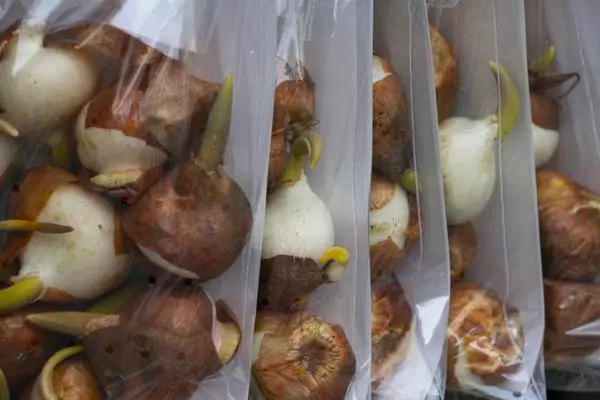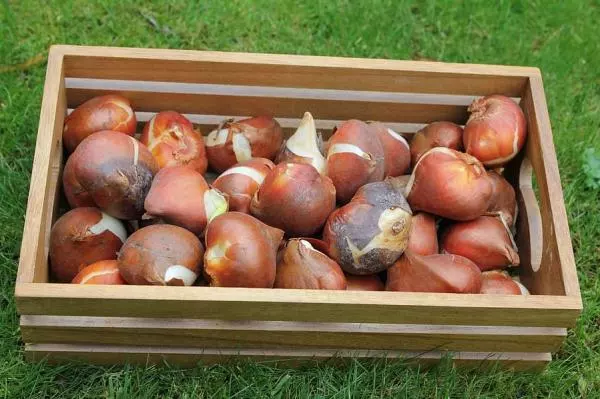Tulips bulbs give splendid spring flowers that appear in a rainbow of colors and countless shapes. Plant them in the fall, before the ground gets cold and hard, and you’ll see them grow and bloom when the weather turns warm in the spring. But you can also grow tulips in water. Learn all about how to grow tulips in water in this article. This is our updated article about how to grow tulips in water in 2024 with comments and questions from our readers.
Table of Contents
How to Grow Tulips in Water
When you buy bulbs, you must take into account that they have no holes and are hard if you are going to grow them yourself. And if you buy them when they have sprouted, it is best that they have not bloomed. You can plant them in a pot or garden, as long as the soil drains the water well so that the bulbs do not get waterlogged up and rot. But there is also the possibility of growing them in water.
To do this, you will need a container that does not allow the bulb to be completely submerged. For it to sprout well, less than half of the bulb should be submerged in water, and it should be changed every ten days to prevent the fungus from growing and rotting the plant. It is necessary to keep the containers in the dark for the first 40-50 days, at about 59°F / 64.4°F (15-18 ºC). You can cover the top of the bulb or cover the entire container with a black plastic bag.
For the bulbs to last as long as possible inside the house, regardless of how they are grown, they should not be placed in the air currents or near the heating. To force the tulip bulbs properly, you must first prepare them and then take care of them during and after the process.
In the comfort of your home, you can adapt it in your interiors in spaces as small as glass, which will also give your house an elegant detail due to the transparency that allows you to see the stems, bulbs, and roots. We use these tulips in our home (Order here).
- Given time to rest, then sorted, to eliminate rotten bulbs!
- For outdoor spring flowers, or indoor winter cheer!
- Harvested this year
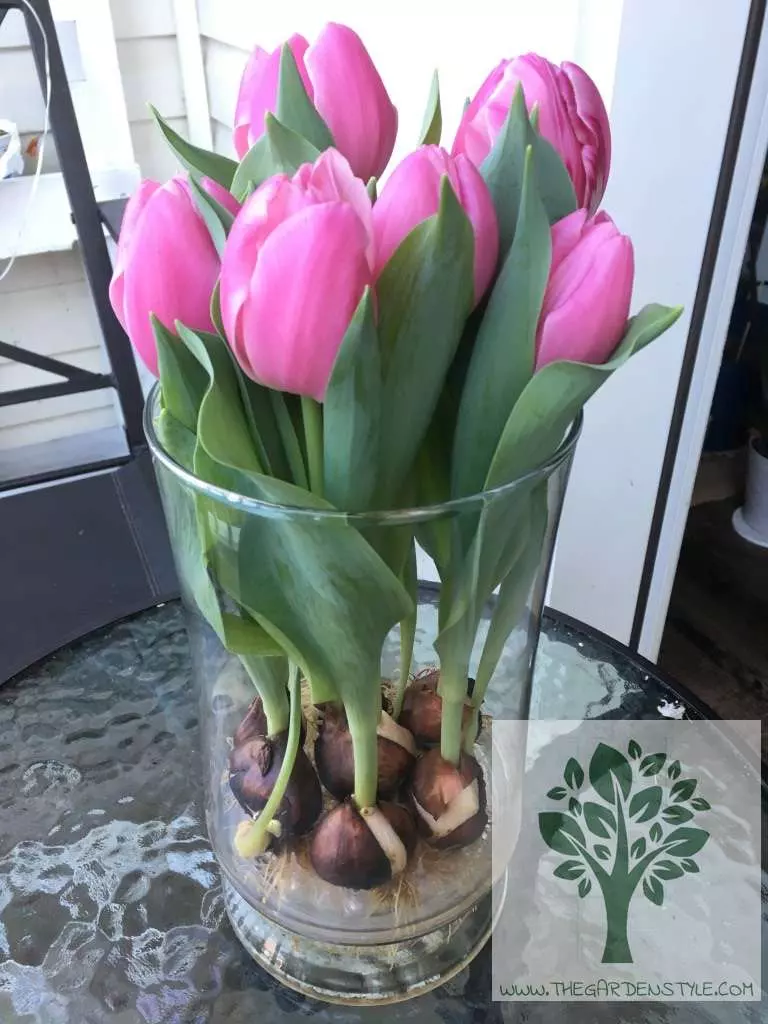
Care Tulips in Water
In winter, avoid excess water, and in summer, water regularly but without waterlogging so as not to cause rot. During the flowering, we will water more often because the water needs of the plants are higher. Water the substrate around the plant. Avoid the neck (base) of the plant and the flower.
The advantage of having good maintenance of the tulips is that they can be replanted when proceeding to divide the bulbs after they can be kept in the best possible conditions. This type of procedure is called “deadheading,” which should be done with great care because the seeds or bulbs that are introduced can prevent the plant from flowering constantly.
You can leave them in the ground for four or five years in a row without them deteriorating, but if you have to take them out to change their pot or you want to give them away, it is best to do so when the stem is already dead.
Take them out of the ground and let them dry in the sun to prevent them from rotting. Remove the roots, store them in a box or a cardboard bag, and cover them with newspaper. You can put another layer of bulbs on top and cover it again with paper. This will help keep them dry all year round.
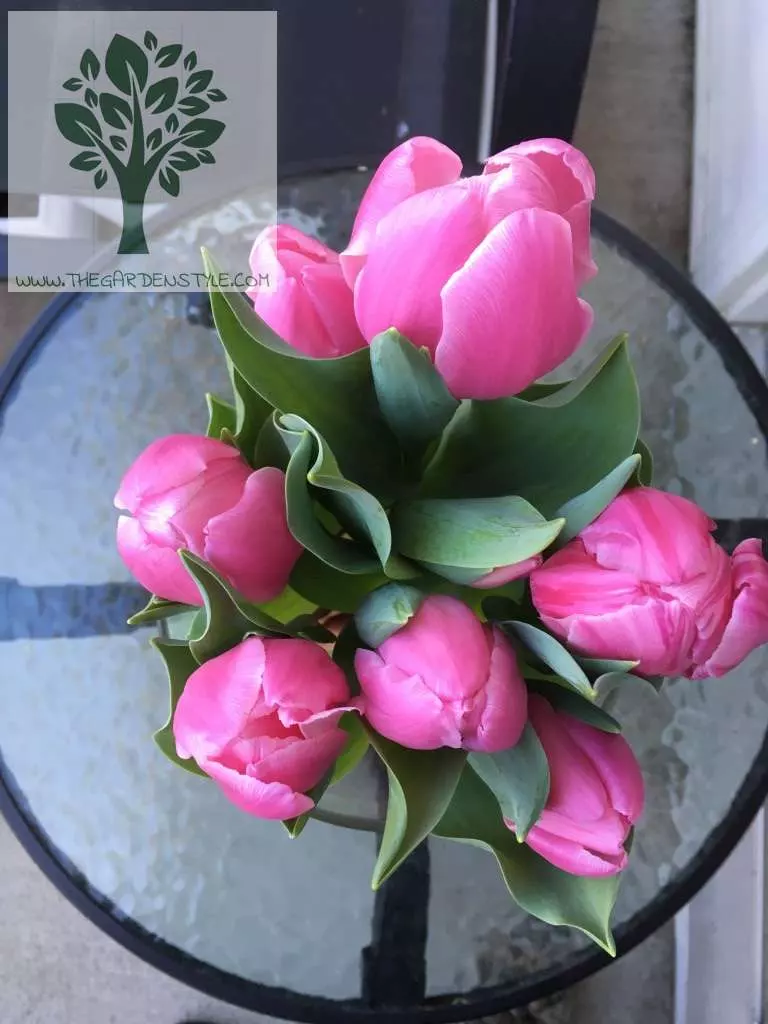
Hydroponic Tulip Vase
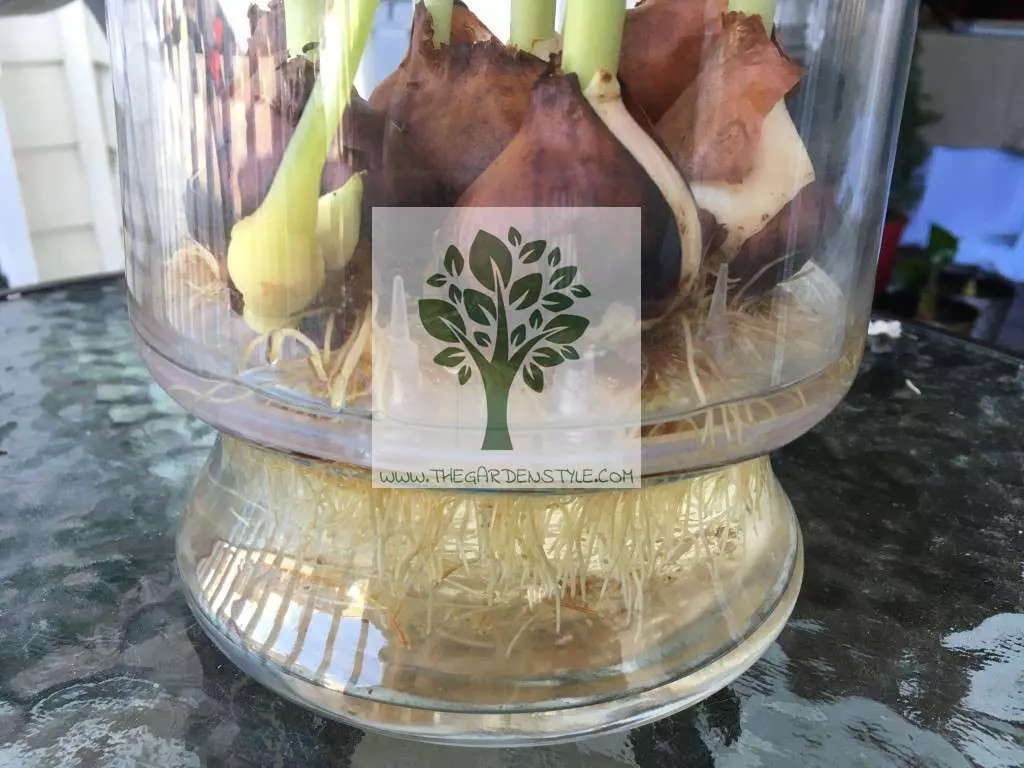
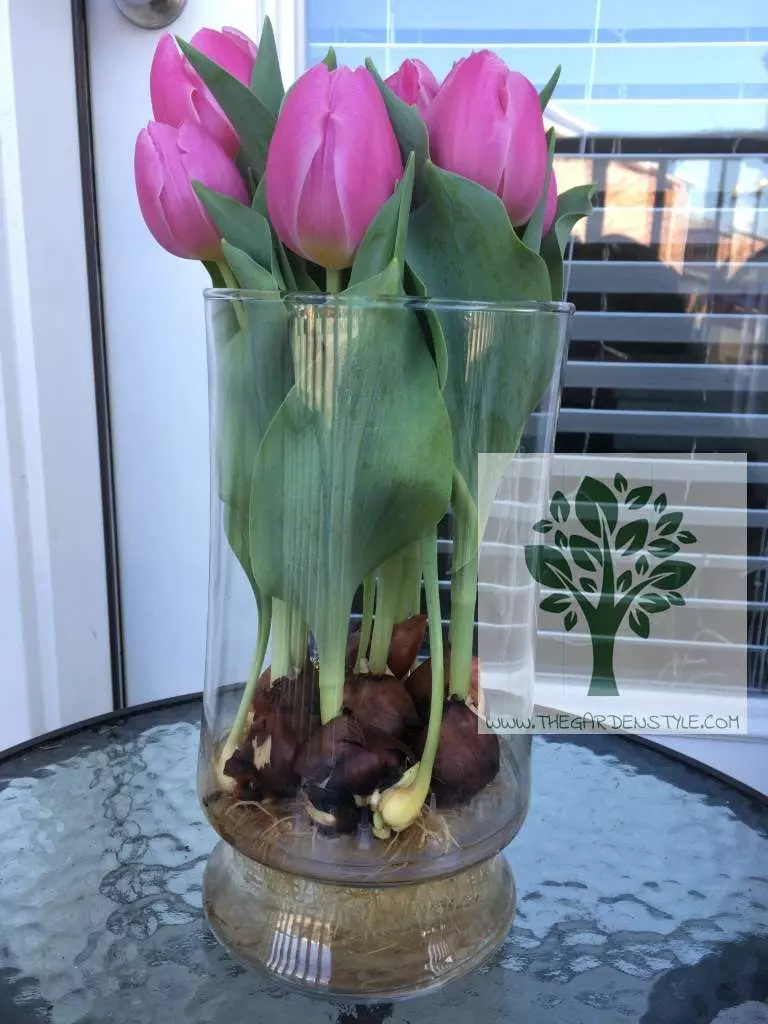
How to Grow Tulips in Water: Advice
To have successful cultivation of tulips in water, some criteria must be met in their care to reach a happy ending. First of all, the tulips must be planted in water, so you must have a bulb at hand, no matter what species or variety of tulips it is. These bulbs cannot be placed in a position in the sun, as they could dry out.
Refrigeration is another piece of advice given by experts regarding care. After they are planted in a tall glass container, the bulbs should be incubated for 12 to 16 weeks in a refrigerator or cooler, taking into account that tulips originate from regions with cold climates and low temperatures, elements that are essential for good growth and development.
Another piece of advice refers to the flowers since once the tulips in water have bloomed, you can prune the stems but only a few centimeters, passing them to another vase or container, which is consistent with the sizes they have assumed so that they do not curl up, nor split.
While in the traditional cultivation of tulips in the ground or pots, irrigation is an important factor in the care, in the case of tulips in water, it is not necessary, but one should be careful to change the water every so often so that it always has fresh water. As long as you give the necessary care, you can show off some splendid tulips in water.
How To Care For Tulips In A Vase
Once the tulips have bloomed, one of the questions we often ask ourselves is “how to care for tulips in a vase”. First of all, we must differentiate which of these 2 options is the one you are looking for to take care of tulips in a vase:
Option 1: Care for tulips in a vase that were previously cut (i.e. stripped of the root and bulb) and will only receive nourishment from the stem.
Option 2: Care for tulips in a vase that have been grown, rooted, and bloomed in water, as previously described, by hydroponic tulip growing, commonly called growing tulip bulbs in water. In this case, tulip bulbs rooted in water have complex root systems and a developed system for accepting nutrients. This will prolong the life of the tulips.
In the following paragraphs, we review the step-by-step care of tulips in water and explain how to do so.
In the first case, for the care of tulips in a vase that was previously cut, there is not much we can do to keep them fresh since the process of deterioration is irreversible. To keep them fresh, it is advisable to use a clean vase, preferably previously boiled and cooled water (it will minimize the bacteria and fungi present in the water), change the water daily, and keep the tulips in cool places avoiding direct exposure to the sun.
As gardeners, the most interesting situation for caring for tulips in a vase is presented in our second case, in which the tulip bulbs grew in water hydroponically and bloomed in water without having been in the ground. Even our readers keep asking “Can you grow tulips in water?“, Oh, yes, of course, you can grow tulip bulbs in water. And let me tell you that as I have explained in this article, growing tulips in water is not difficult if you follow our tips. So, once we have our fully grown and water-grown tulips in bloom, the next step is to understand how to care for tulips in a vase. At this point, the tulip bulbs already have well-developed root systems that are perfectly adapted to water, so the tulip bloom has occurred and the root system of the tulip bulbs is perfectly developed to accept nutrients and maintain the bloom. So here are some tips on how to care for tulips in a vase and prolong the life of blooming tulips for your enjoyment.
Tulips In Water Vase Care
In the following steps are our tips for caring for tulips in a vase and how to care for tulips in water – See our tulips in water vase care checklist
1 – keep the glass container clean, keep the water clean, and renew it frequently, at least once a week.
2 – use good quality water. To prolong the life of the root system of tulip bulbs and to avoid diseases it is recommended to use good quality water. If the only source of water is well water, it is advisable to boil and cool it. Never put hot water on the bulbs. Use boiled and cooled water. Tap water may be filtered or even boiled and cooled because this is a good option to minimize the growth of undesirable bacteria on the surface of the glass container.
3 – a very common mistake is to try to transfer tulip bulbs with roots grown in water (whether they have flowered or not) to soil or a mixture of soil and sand. The root system of tulip bulbs is completely adapted to water. Changing the medium of transport of these nutrients is not recommended.
4 – the last tip for caring for tulips in a vase is to keep them in a cool environment and avoid prolonged exposure to the sun. Keep in mind that when you place the vase in the sun, both the glass container and the water in the container heat up quickly and this heat, in addition to the magnifying effect that the sun may have on the roots through the glass, is not recommended. If prolonged sun exposure has occurred, change the water in the vase for fresh, renewed water. This will help to lower the temperature while allowing the amount of evaporated water to be recovered quickly.
What To Do With Tulip Bulbs In Water After Flowering
What To Do With Tulip Bulbs In Water After Flowering After flowering, the bulbs can be removed and stored for the next season. You can regrow them next year. We recommend this article to learn how to store tulip bulbs.
After your bulbs have stopped flowering for the first time, remove the dead flower from the stem and allow the remaining foliage to die off while keeping the water level in the glass vase at a safe level. When the leaf has dried completely, you may notice new small bulbs forming; leave them alone.
Remove the leaves but leave the roots, and keep the bulbs dry and cold until early November. Then, using a healthy mix of soil and compost, put them in your garden according to your zone, and be sure to water them properly when first planting them.
Here’s where you can locate your planting zone: The USDA Plant Hardiness Zone Map might help you figure out when the optimum time is to transplant the bulbs once they’ve dried up:
- September or early October in Zones 4 and 5.
- October to early November in Zones 6 and 7.
- November to early December in Zones 8 and 9.
- Late December until early January in Zone 10
Tulip bulbs should be refrigerated for six to eight weeks before planting if you reside in zones 8 through 10. Place them in a paper bag and keep them away from ripening fruits before refrigerating (fruits produce ethylene gas, which can destroy the flower bud within the bulb).
Tulips thrive in full light and well-prepared, fast-draining soil. Avoid planting the bulbs in areas where water gathers or where late frosts are likely.
How to Grow Tulips in Water (or Re-Grow Tulip Bulbs in Water)
Let’s review in the following paragraphs How to Grow Tulips in Water (or Re-Grow Tulip Bulbs in Water) the following year. Growing tulips in the soil gives you the highest chance of success, but if you want to try growing tulips in the water again, here are the methods we propose.
Before attempting to push tulip bulbs into the water, we recommend allowing them to recuperate in the soil as described above or chilling your bulbs for 12 to 15 weeks in a paper bag in the refrigerator.
Fill the old Bloomaker vase 2 inches deep with rock or glass when you’re ready to plant them, then set the tulip bulb on top with the pointy region erect. The goal here is to utilize the beads or rocks to keep the bulb out of the water while enabling the roots to get hydration.
Then, fill the vase with water until it reaches 1 inch below the bulb’s bottom. Then, after 4 to 6 weeks, place the bulb and vase in a cool, dark spot.
Finally, change the water often, approximately once a week, and keep a lookout for sprouting.
When the bulbs begin to sprout, you may bring them back out into the open and care for them as you did the first time they blossomed.
Can Tulips Grow In Water?
Some of our readers have specifically asked us after reading this article, “Can tulips grow in water?” If you are looking to grow tulips in water, a tulip cut directly in water, forget it. This is not possible. Many try this without success, and this is because the stem of the tulips does not elaborate roots. The roots of tulips are at the level of the bulbs. It is possible to root a rose in water, but not a tulip in water. Therefore, it is not possible to grow a tulip in water. However, you can grow tulip bulbs in water and bloom them. This way, you can try growing tulips indoors in water and then follow our advice on how to take care of them.
We have already reviewed how to grow tulip bulbs in a vase that will allow the practice of growing tulips indoors in water just by keeping the tulip bulb in water properly. Easy, isn’t it?
So this article answers a lot of the questions we have received from our readers like “How to plant tulip bulbs in water?“, “Can tulips grow in water?“, “Can you grow tulips in water?“. We hope these tips will help you learn and practice about growing tulip bulbs in water and how to take care of tulips in water.
This is all about Growing Tulips in Water, but you can learn more about how to plant tulips.
Did you know that it is possible to grow daffodil bulbs in water? Daffodil bulbs are also very attractive for growing in water. See our article on planting and growing Daffodil bulbs in the water here.
We recommend our article about How to Grow Fresia.
Pin it for later!
